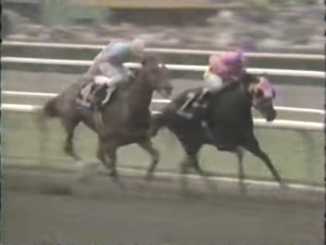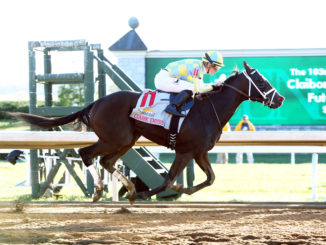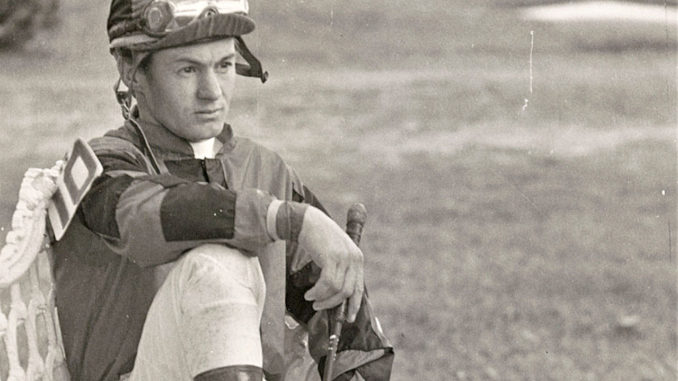
The ninth decade of life typically isn’t one in which the retired expect to be overly active or in the spotlight, but for Hall of Fame jockey Ron Turcotte, the next few years figure to be busier than normal.
Turcotte, who turns 80 on July 22, is the last survivor among the inner circle connected with the legendary Secretariat, whose racing career will be recalled and celebrated over the next few seasons, as the 50th anniversary of his racing accomplishments approaches. There is also an overlapping anniversary involving Turcotte’s second most famous mount, Secretariat’s older Hall of Fame stablemate Riva Ridge.
With reflections on Secretariat (and to a lesser extent, Riva Ridge) a well-trodden topic going on half a century, and with more to come, Turcotte was kind enough to share thoughts and memories about some of the other significant horses, personalities, and events of his illustrious career when reached at his Grand Falls, New Brunswick, home last month.
Northern Dancer
Although he didn’t get to ride him to his notable victories in the 1964 Kentucky Derby, Preakness, and Queen’s Plate, Turcotte was there at the beginning for Northern Dancer, Canada’s most famous and influential Thoroughbred son.
Turcotte was a five-pound apprentice when he climbed aboard Northern Dancer for the colt’s debut in a six-furlong maiden race at Fort Erie on Aug. 2, 1963, which the E. P. Taylor homebred proceeded to win by a widening 6 3/4 lengths.
“I was very high on him,” Turcotte said. “When I rode him in his first race, he was kind of lazy-like. I just had to tap him once, and he took off. I knew he was heading for something big.”
Northern Dancer made his stakes debut 15 days later, in the 6 1/2-furlong Vandal at Fort Erie, but without Turcotte in the saddle. Turcotte was contractually bound to ride a colt named Ramblin Road.
“(Trainer Horatio) Luro got real mad at me, but there was nothing I could do,” Turcotte said. “My contract holder owned Ramblin Road, and I couldn’t ride against my contract holder. I knew I was riding the second-best horse”
Turcotte might have felt he was riding the second-best horse, but the betting public favored the more experienced Ramblin Road, who started as the 3-5 favorite, after a romping win in the Victoria at Woodbine and an earlier second-place finish to the brilliant Raise a Native in an Aqueduct allowance.
Ramblin Road conceded Northern Dancer 13 pounds in the Vandal, but Turcotte rode a savvy race, which resulted in a four-length win for his mount.
“Northern Dancer hooked up with another horse and they were killing each other,” Turcotte said. “I just sat back behind them and galloped past. I shouldn’t have beat him.”

Turcotte rode Northern Dancer three more times and won twice. The most emphatic was a 6 1/4-length triumph in the 1 1/8-mile Coronation Futurity at Woodbine.
“Not only did he have foot trouble as a three-year-old but also as a two-year-old,” Turcotte said of Northern Dancer, who notably struggled with quarter-crack issues. “They had to keep patching it.
“He was an extremely good horse — a great horse. I’d have to pick him as the second-best horse I ever rode.”
November 22, 1963
Turcotte was riding at Pimlico on Friday, Nov. 22, 1963, the day President John F. Kennedy was assassinated.
“I remember very well, when the announcer said the remainder of the card was being canceled,” Turcotte said.
While most tracks throughout the country went dark until after Kennedy’s funeral the following Monday, Pimlico went ahead with its Saturday program, ostensibly to avoid the cancellation or postponement of the lucrative Pimlico Futurity. Nominators had already paid roughly $100,000 toward the Futurity purse, the equivalent of more than $850,000 today.
“The nominations and the fees were all started two years ago, and these horses and riders have shipped in from all over the country,” Maryland Racing Commission chairman Bruce Livie told the Baltimore Sun at the time. “If we weren’t running something like the Futurity, we’d certainly cancel. I don’t see how we can put it off.”
While Turcotte’s mount in the Futurity ran out of the money, he rode one winner earlier on the card, his ninth of the 10-day-old meet. The program was contested in dreary conditions, both weather-wise and in mood.
“He was very, very well loved in Maryland,” Turcotte said of Kennedy. “The crowd was crying. It was a very sad day.”
Tom Rolfe and Damascus
Turcotte’s first taste of classic success came in 1965, when he guided that year’s champion colt, Tom Rolfe, to victory in a thrilling edition of the Preakness.
“He was a long time coming around,” Turcotte recalled of the Ribot colt, whom he won aboard three times as a two-year-old, most notably in the Cowdin at Aqueduct. “He really matured to come into his own.”
Turcotte was also aboard for all three of Tom Rolfe’s wins leading up to the Kentucky Derby in the spring of 1965, but the pair wound up third to Lucky Debonair in the Run for the Roses. That form was reversed in the Preakness, where Tom Rolfe was all out to defeat Dapper Dan by a neck, with Lucky Debonair a distant seventh.
Three weeks later, in the Belmont, which was contested that year at Aqueduct, Tom Rolfe lost in the final strides, by a neck, to Hail to All.
“I didn’t win the Belmont with him, but that was my fault. I moved a little soon,” Turcotte said.
Turcotte also had an opportunity to ride the Hall of Fame colt Damascus on two occasions. While he had no trouble piloting Damascus to a facile win in the 1967 Leonard Richards at Delaware Park as a 1-10 favorite, Damascus lost a stretch duel with Most Host in the 1968 Charles H. Strub at Santa Anita, where the reigning Horse of the Year started at 1-5.
The track was listed as slow, an anachronistic rating formerly used to describe a surface between muddy and good.
“I knew he was a great horse,” Turcotte said of Damascus. “When I rode him at Santa Anita, he was the only horse not running with mud caulks. He was slipping a lot and cut himself pretty good. Otherwise, he would have won the race.”
Tom Rolfe and Damascus were both trained by Frank Whiteley, who, despite his curmudgeonly reputation, has long been considered one of the finest horsemen in racing history.
“I got along real good with Frank Whiteley,” Turcotte said. “He was kind of a loner. He didn’t like to speak to the press and stuff like that.”
Turcotte’s relationship with Whiteley also extended to riding, on occasion, Damascus’ “rabbit,” Hedevar, most notably in the 1967 Woodward at Aqueduct, a race that pitted Hall of Famers Buckpasser, Damascus, and Dr. Fager against each other. The connections of Buckpasser and Damascus both employed rabbits to soften up the speedy Dr. Fager.
Turcotte mentioned Buckpasser and Dr. Fager when asked which horses he would have liked to have ridden but didn’t get a chance to, but he did his part aboard Hedevar to ensure a tactical 10-length win for Damascus, an anticlimactic finish to what was referred to at the time as the “Race of the Century.”
“I felt bad doing it, but it was my job,” the rider said.
Shuvee, Fanfreluche, and Summer Guest
Just before Secretariat came to the fore, Turcotte had exceptional success with several notable fillies. Foremost was Shuvee, who to this day remains the only female ever to win the Jockey Club Gold Cup, then contested over two miles.
Turcotte rode Shuvee for the first time in the 1968 Selima at Laurel, which Shuvee won by a neck, over that season’s co-champion juvenile filly, Process Shot. However, according to Turcotte, he missed out on riding the filly to her sweep of New York’s Triple Tiara for fillies — the Acorn, Mother Goose, and Coaching Club American Oaks — in 1969, because her owners preferred to have a rider under contract, in this case Jesse Davidson.
Turcotte picked the mount back up in the summer and fall of 1970, when Shuvee won the Diana, Beldame, and the first of her back-to-back Jockey Club Gold Cups, en route to her first divisional championship. Turcotte was also aboard Shuvee when she captured the Top Flight and Diana in 1971.

Fanfreluche, the co-champion three-year-old filly in the U.S. and Horse of the Year in Canada, was another Turcotte had fun with in the summer and fall of 1970. They earned their first stakes win together in the Manitoba Centennial Derby at Assiniboia Downs, before an audience that included Queen Elizabeth II. Later, they teamed up to win the Alabama at Saratoga and the Quebec Derby at Blue Bonnets Raceway in Montreal.
One prize that eluded them, though, was the Queen’s Plate. Chris Rogers, who rode Fanfreluche regularly prior to the Plate, provided Turcotte with some advice.
“Chris Rogers said, ‘Ronnie, sit on her as long as you can,'” Turcotte said. “A hole opened, and I let her go through there, but it was a little too early.”
Almoner, the slight favorite in the wagering over Fanfreluche, wore down the filly to win by three parts of a length.
Sadly for a native Canadian, Turcotte never tasted success in the Queen’s Plate. However, he says it doesn’t bother him.
“Winning the Queen’s Plate is the thing in Canada, but I’d rather have gone to the States and done all that I did,” he said. “It was the pinnacle of my career. I really have no regrets.
“Even though I couldn’t ride Secretariat for the last time, I was happy to have prepared him for the Canadian International, which I won two of them anyway (aboard Will I Rule in 1964 and Vent du Nord in 1969).”
Summer Guest, one of the top three-year-olds of 1972, was another star filly Turcotte had an opportunity to ride. Together, they teamed up to win the Black-Eyed Susan, Coaching Club American Oaks, Monmouth Oaks, and Alabama.
“She could really run,” Turcotte said. “She was the reason I didn’t ride Secretariat the first time, because I had a commitment to ride her at Monmouth Park.”
Fort Marcy and the Dixie DQ
Besides Summer Guest, Turcotte also took the call from owner Paul Mellon and trainer Elliott Burch several times on Fort Marcy, the gelding who won or shared three grass titles.
Turcotte guided Fort Marcy to a couple of his earliest stakes wins, in the 1967 editions of the Tidal at Aqueduct and a division of the Bernard Baruch at Saratoga. Fort Marcy was a three-year-old facing older in both, and in the Baruch, he toppled reigning grass champion Assagai.
However, it was Turcotte’s ride on Fort Marcy in the 1971 Dixie at Pimlico that produced one of the more bizarre outcomes of his career.
Heavily favored at 7-10 in the 1 1/2-mile Dixie over soft ground he relished, Fort Marcy crossed the finish line six lengths in front. However, a claim of foul against Fort Marcy by the jockey of fourth-place finisher North Flight, Tommy Lee, was soon lodged. North Flight had led the Dixie for more than 1 1/4 miles when Fort Marcy roared past on the final turn, at which point Lee stood up in the irons.
“It was very, very foggy,” Turcotte recalled. “You couldn’t see your hand in front of your face. I was never close to any horse. The horse they said I bothered wasn’t even around me.”
According to a contemporary report in the Baltimore Sun, the patrol camera that would have given stewards the best angle malfunctioned shortly before the incident, thus footage from a camera farther away was used to adjudicate the claim of foul. The claim was allowed, and Fort Marcy was disqualified to fourth, despite being overwhelmingly best.
“Lee ought to get an Academy Award,” Turcotte fumed to the Sun. “The film also lied.”
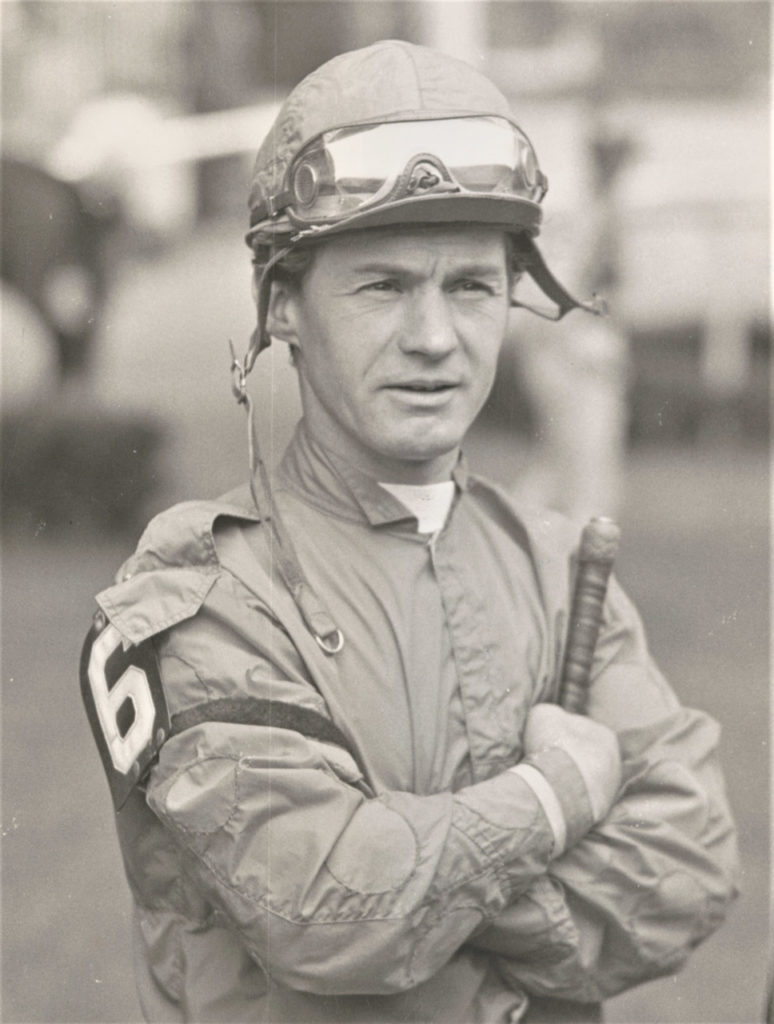
Turcotte was handed a five-day suspension for careless riding, but appealed on the advice of Fort Marcy’s connections. The patricians Mellon and Burch cared little, though, about the loss of the winner’s share of $36,920, the equivalent of a quarter-million dollars today.
“Mr. Burch is the man that pushed me to appeal,” Turcotte remembered. “He said don’t appeal for the money. They both said that. Just appeal for yourself, so you can keep a clean record.”
Five days later, the Maryland Racing Commission heard Turcotte’s appeal for several hours, during which the lack of clarity in the footage available became evident.
“The patrol judge wore very thick glasses and couldn’t see very good,” Turcotte said. “He approached the TV monitor and showed the commission, ‘See where he fouled him?’ ‘Yes, we see very well, and he was never close to him.’
“After the hearing, when I walked out, they said, ‘You’re clear. We can’t see no foul there. Are you appealing for yourself or for the purse?’ I said I’m appealing for myself to keep a clean record.”
The commission voted 3-1 in Turcotte’s favor and reduced his suspension from five days to three days, which allowed him to fulfill his commitment to ride in the Acorn at Aqueduct two days later. However, for poor Fort Marcy, his permanent record remains stained with an arguably unjust disqualification that took away a 17th and final stakes victory from his Hall of Fame career.
Dahlia and the “Greatest Ever” tiff
In the year following Secretariat’s retirement, Turcotte had an opportunity to ride the superstar European filly Dahlia. In her second sojourn to North America, in the fall of 1974, Dahlia aimed first for the Man o’ War at Belmont Park.
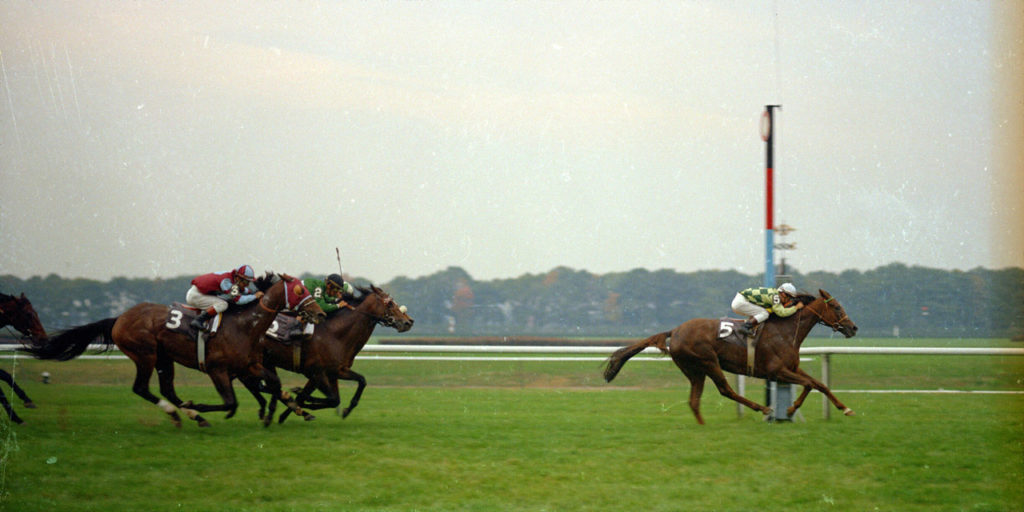
“She had missed some time because she was in quarantine, and Lester Piggott was supposed to come and ride her,” Turcotte recalled. “They didn’t think she was quite fit for the race, so (her connections decided to) let a local boy ride her. That local boy happened to be me.”
Despite an extraordinary record that included wins in two editions of the King George VI and Queen Elizabeth, a Washington D.C. International, a Grand Prix de Saint-Cloud, and three other Group 1 tests, Dahlia was sent off as a bargain 2.4-1 favorite. Although the margin of victory was only two lengths, video suggests she could have outclassed the field by more.
“She wasn’t the easiest filly in the world to ride,” Turcotte said. “She could really run. She was eager to run. You had to fight with her a little bit to get her to relax.”
Turcotte’s characteristic diplomacy in the wake of the Man o’ War, however, would anger owner Nelson Bunker Hunt and trainer Maurice Zilber, and he never rode the filly again.
“I find it funny now. After the Man o’ War, I went to the barn to see her and to see how she came out of the race. That was a custom I had,” Turcotte said. “Mr. Hunt and Mr. Zilber were after me to tell the whole world that was the greatest horse I ever rode. On the heels of riding Secretariat, there’s no way in the world I could say that.
“I told them, ‘Look, I never compare anybody’s horses. It’s not fair to the one I’m not going to pick. Everybody’s out there to have the best horse.’
“After I refused to compare them, (my agent was told), ‘You can take Ronnie off. Piggott’s gonna ride (her in the Washington D.C. International).'”
Following an interim victory in the Canadian International, Dahlia was made the 3-5 favorite to repeat in the Washington D.C. International, with Piggott up. Turcotte wound up with a mount on Desert Vixen, a two-time champion filly on dirt who had zero experience on turf or as far as 1 1/2 miles.
Although Desert Vixen had a reputation for sometimes setting sprint-like fractions in her route efforts, Turcotte surmised that her best chance at victory would be to slow the pace way down. Over a course rated firm, Desert Vixen set absurdly soft splits of :27.20, :51.80, 1:17.20, 1:42, and 2:06.40. Meanwhile, a seemingly overconfident Piggott had Dahlia languishing some seven lengths behind Desert Vixen for much of the journey.
“I didn’t believe they let me get away with that,” Turcotte said. “When I looked back and saw they had such a tight hold of their horses, I just backed mine down and got away with some easy fractions.”
Admetus, a 31-1 outsider from Europe, raced in close attendance with Dahlia near the back of the field but was wisely asked to improve position approaching the mile mark. That middle move proved decisive, as Admetus was in much better position to challenge Desert Vixen in the stretch than Dahlia.
If not for a distraction in the final furlong, Turcotte feels Desert Vixen could have held on to beat Admetus, who got the better of her by three-quarters of a length.
“She came to the tote board when she was on the lead, and when the lights starting flashing, she ducked out,” Turcotte said. “If not for the blinking lights and her ducking, I would have won the race.”
Instead, Turcotte had to suffice with outwitting the great Piggott and having the last laugh over the obstinate connections of Dahlia.
Arcaro’s greatest: Citation or Kelso?
As Turcotte is inexorably linked with Secretariat, so was Eddie Arcaro with Secretariat’s Triple Crown-winning predecessor, Citation. In the wake of Secretariat’s Triple Crown sweep in 1973, the two horses were often compared.

While Arcaro was quoted during his lifetime as saying Citation was his greatest mount, Turcotte stands by remarks he penned in a Blood-Horse column more than 20 years ago, when he wrote Arcaro truly felt Kelso was superior to Citation. Arcaro regularly rode Kelso during the first two of the gelding’s five consecutive Horse of the Year campaigns.
“He never once told me otherwise,” Turcotte said. “Every time I asked him who the best horse he ever rode was, he’d always say Kelso. Arcaro always told me he never let Kelso run.
“He said, ‘I had many big races with (Ben and Jimmy Jones). I was friends with them. I just didn’t want to make them feel bad.'”
Images from the Keeneland Library are protected by copyright and may not be reproduced in print or electronically without written permission of the Keeneland Library.


